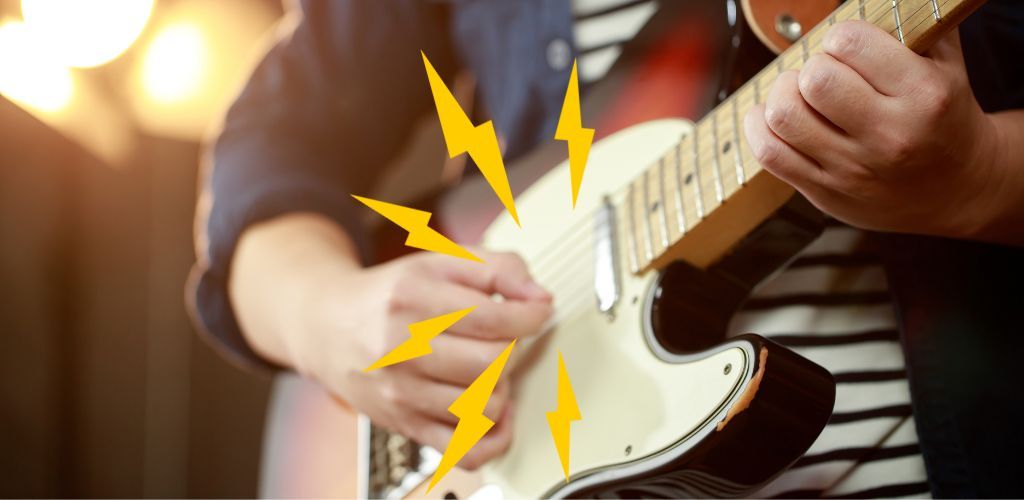Picking up your electric guitar and realizing it’s more than just a musical instrument; these aren’t your usual rock ‘n’ roll cliché.
Yes, you’re reading that correctly—people are strumming, shredding, and sautéing all at once!
I’ve stumbled upon some absolutely mind-boggling, jaw-dropping ways people are using their guitars, and I just had to share!

Creating electronic music with MIDI guitars
MIDI guitars have revolutionized electronic music creation, allowing guitarists to seamlessly integrate their playing into digital audio workstations and synthesizers.

By converting the guitar’s output into MIDI data, musicians can trigger virtual instruments, control parameters, and layer complex textures and effects, all while retaining the expressive nuances of their playing.
This technology has opened up a world of creative possibilities for guitarists, enabling them to explore new sonic territories and push the boundaries of what is possible with electronic music production.
Using guitars as controllers for video games
Guitars have found a new role in the world of video games, serving as innovative controllers that allow players to experience music in a more interactive and immersive way.

Games like Guitar Hero and Rocksmith have popularized the use of guitar-shaped controllers, which enable players to simulate the experience of playing along with their favorite songs by pressing buttons and strumming in time with on-screen prompts.
This fusion of gaming and music has not only introduced a new generation of players to classic rock and pop songs but has also inspired many to pick up a real guitar and learn to play, blurring the lines between virtual and real-world musical experiences.
Integrating guitars into virtual reality experiences
As virtual reality technology continues to advance, guitars are finding new applications in immersive digital environments

By combining VR headsets with motion-tracking controllers and virtual instruments, developers are creating experiences that allow users to play and interact with guitars in entirely new ways, from jamming with virtual bandmates to exploring fantastical musical landscapes.
These VR guitar experiences not only provide a novel form of entertainment but also offer new possibilities for music education and training, allowing aspiring guitarists to practice and learn more engagingly and interactively.
Employing guitars in sound healing and therapy sessions
Guitars are increasingly being used in sound healing and therapy sessions, thanks to their ability to create soothing, resonant tones that can help to relax the mind and body.

Therapists and sound healers can create immersive soundscapes that promote calm, reduce stress and anxiety, and encourage emotional release and self-reflection by playing specific chord progressions, arpeggios, and ambient textures.
The versatility and accessibility of the guitar make it an ideal instrument for these therapeutic applications, offering a gentle and inviting way to explore the transformative power of music and sound.
Designing guitars with 3D printing technology
3D printing has changed the way guitars are designed and built. Now, luthiers and makers can make guitars with complicated shapes, special materials, and personalized features that would be difficult or impossible to achieve with old-fashioned methods.

By using 3D modeling software and advanced printing techniques, designers can prototype and refine their ideas quickly and efficiently, experimenting with different body styles, headstock shapes, and bridge configurations to optimize tone, playability, and aesthetics.
This technology also enables guitarists to create personalized instruments that are tailored to their specific needs and preferences, whether it’s a one-of-a-kind custom build or a modified version of a classic design.
Using guitars to control stage lighting and effects
Guitars are not only instruments for creating music but can also be used as controllers for stage lighting and effects, adding a new dimension of visual expression to live performances.

By equipping guitars with special sensors, MIDI pickups, or motion-tracking devices, musicians can trigger changes in lighting, video projections, and other visual elements in real time, creating a more dynamic and immersive experience for the audience.
This technology allows guitarists to become more than just musical performers; they can also be visual artists and storytellers, using their instruments to shape the entire sensory experience of a live show.
Building custom guitars from recycled materials
As concerns about sustainability and environmental impact continue to grow, some guitar enthusiasts are exploring the possibilities of building custom guitars from recycled materials.

By repurposing everything from old furniture and floorboards to discarded metal and plastic components, these builders are creating unique instruments that not only sound great but also tell a story about the materials’ past lives.
This approach to guitar construction not only reduces waste and promotes eco-friendly practices but also results in one-of-a-kind instruments with distinctive visual and tonal characteristics that reflect their unconventional origins.
Creating art installations with deconstructed guitars
Deconstructed guitars have become a popular medium for creating art installations that explore the intersection of music, sculpture, and visual expression.

By disassembling and rearranging guitar components, artists can create striking and thought-provoking pieces that challenge our perceptions of the instrument and its role in culture and society.
These installations often incorporate elements of sound, light, and interactivity, inviting viewers to engage with the artwork in new and unexpected ways and prompting reflection on the nature of creativity, destruction, and transformation.
Using guitars to generate electricity (yes, really!)
In recent years, researchers and innovators have been exploring the potential of using guitars and other musical instruments to generate electricity.

By harnessing the kinetic energy of vibrating strings and converting it into electrical current, these experimental devices can power small electronics, such as effects pedals or tuners, directly from the guitar’s output.
While still in the early stages of development, this technology holds promise for creating more sustainable and self-sufficient solutions for musicians, reducing reliance on batteries or external power sources, and opening up new possibilities for off-grid performances and recording sessions.
Incorporating guitars into robotics and AI projects
Guitars are finding new applications in the world of robotics and artificial intelligence as researchers and engineers explore ways to create machines that can play and compose music with human-like skill and creativity.

These projects aim to replicate the skill and expressiveness of human guitarists by equipping robots with specialized grippers, sensors, and machine-learning algorithms. They also push the boundaries of what is possible with automated music generation.
As these technologies continue to advance, we may see the emergence of new forms of musical collaboration and performance, blurring the lines between human and machine creativity.
3 Electric Guitars for your playing needs
Epiphone 100 Les Paul

PERFECT FOR: Beginners
FEATURES: The best part of the model is that it offers quality sound effects. It comes with a rosewood fingerboard.
OTHER INFO: The instrument has 700T/650R open-coil humbucker hardware making it suitable for beginners who love to play the guitar with good sound.
Epiphone 100 Les Paul
- Beginners and intermediary players can play easily.
- The model offers ease and fun to play.
- Sturdy Construction provides a lifetime warranty.
- It is a Cost-Effective Model with reasonably good pickup.
- The convenient design provides the best support for repair/replacement.
- The Lightweight Electric Guitar comes with wide-ranged tonal variations that offer versatility.
- The product lacks an Amplifier, Cable, and Guitar stand.
- It isn't easy to tune for the newbies.
- The model's Slim design makes it convenient only for short- or medium-statured people.
- The Short Scale length needs to make it more suitable for seasoned players.
When you click ‘Check Price’, you’ll see there are loads of great places to buy this item. Our personal favorite is Sweetwater for the US, and Thomann and Gear4Music for the UK & Europe.
They are the largest music retailers, with excellent customer service, competitive prices, really fast shipping, and the longest guarantees.
The professional musician who wrote this article combined many things,
from the product build, manufacturer’s reputation through to feedback
from other users, to create our famous TedScore™.
Yamaha PAC311H

PERFECT FOR: Both Professional and Beginners
FEATURES: a solid Alder Body construction, a maple neck & rosewood fingerboard.
OTHER INFO: There's a Stop Tail Bridge to make it one of the best of its kind.
Yamaha PAC311H
- The neck is thin and smooth to offer the comfort of playing it.
- The instrument provides tonal variety.
- It doesn't require regular tuning and stays in tune for weeks at a stretch.
- The Lightweight design aspect offers maximum comfort to players.
- You will always need a professional to set it up.
- Little fret buzz is a common problem.
- The tone is thin, which only offers a pleasant experience to some.
When you click ‘Check Price’, you’ll see there are loads of great places to buy this item. Our personal favorite is Sweetwater for the US, and Thomann and Gear4Music for the UK & Europe.
They are the largest music retailers, with excellent customer service, competitive prices, really fast shipping, and the longest guarantees.
The professional musician who wrote this article combined many things,
from the product build, manufacturer’s reputation through to feedback
from other users, to create our famous TedScore™.
Stewart Travel Guitars

PERFECT FOR: Traveling Guitarists
FEATURES: The updated version of this guitar includes Graphtec saddles, .010 strings and single-coil pickups.
OTHER INFO: It comes with a protective backpack case to make it travel-friendly.
Stewart Travel Guitars
- The product possesses a full money-back guarantee.
- It offers top performance and quality.
- It's not fit for those looking for tuneful resonance.
When you click ‘Check Price’, you’ll see there are loads of great places to buy this item. Our personal favorite is Sweetwater for the US, and Thomann and Gear4Music for the UK & Europe.
They are the largest music retailers, with excellent customer service, competitive prices, really fast shipping, and the longest guarantees.
The professional musician who wrote this article combined many things,
from the product build, manufacturer’s reputation through to feedback
from other users, to create our famous TedScore™.
Electric Guitar Revolution:
Future of Music
People are employing electric guitars in more diverse and unexpected ways, ranging from controlling stage lights and generating electricity to cooperating with artificial intelligence.
These innovative applications showcase the instrument’s versatility and adaptability and demonstrate the boundless creativity and ingenuity of the musicians, artists, and researchers who are pushing the boundaries of what is possible with the electric guitar.
As technology continues to evolve and new ideas emerge, we can expect to see even more surprising and groundbreaking uses for this iconic instrument, redefining its role in music, art, and society as a whole.
Whether you’re a seasoned guitarist or simply a fan of creative innovation, these 10 unbelievable ways people are using their electric guitars are sure to inspire and amaze you, offering a glimpse into the exciting future of this beloved instrument.











using guitars made from recycled stuff is kinda cool. saves the planet one riff at a time, yeah?
Absolutely, Vicky_S! It’s both innovative and environmentally conscious.
While the concept of using 3D printing technology to design guitars is undoubtedly innovative, I wonder about the impact on sound quality compared to traditional woodcraft. There’s a certain warmth and resonance in a wood-built guitar that I’m skeptical 3D printed materials can replicate. Has anyone compared the sound profiles extensively? I believe craftsmanship in guitar making is an art that shouldn’t be fully replaced, though technology offers intriguing possibilities for customization and cost reduction.
The idea of using guitars to control stage lighting and effects is just mind-blowing. Really makes you think about the future of live performances. Can’t wait to see this in action!
The section on creating art installations with deconstructed guitars caught my eye. There’s something profoundly beautiful about giving old instruments a new lease on life as pieces of art. It speaks volumes about our ability to reimagine and repurpose. Would be interested to see how artists are approaching this.
Totally agree, Giulia! It’s amazing to see instruments turned into something visual. There’s so much potential there.
can guitars really control stage lighting and effects that sounds wild hows it even done
I was particularly intrigued by the section on designing guitars with 3D printing technology. The potential for customization and innovation in guitar designs is truly limitless with this technology. It’s exciting to think about the unique instruments that could emerge from such a creative process. Kudos to the creator for highlighting this futuristic approach to guitar-making.
Hey Lewis, loved reading about guitars in VR. How do you see this tech evolving? Could we be playing in virtual bands soon?
Virtual bands sound epic. Imagine the possibilities!
Absolutely fascinated by the idea of guitars generating electricity! How does that even work? Lewis, you’ve got me hooked on this concept. Gotta love when music meets innovation.